Economical Evaluation and Optimal Energy Management of a Stand-Alone Hybrid Energy System Handling in Genetic Algorithm Strategies
Abstract
1. Introduction
2. Models of the Hybrid System Components
2.1. Wind Turbine Model
2.2. PV Array Model
2.3. Tidal Turbine Model
2.4. Storage System and Converter Models
2.5. Electrical Load Model
3. Power Management and Operation Strategy
- (1)
- If , the hybrid renewable sources supplies the load power demand.
- (2)
- If , the surplus power will be used to charge the battery bank, but if battery bank is completely charged the surplus power will dump or will inject into the electric grid in the case of its proximity.
- (3)
- If , the battery bank will produce the remaining power to feed the electrical load.
4. Objective Function and Constraints
- The electrical load is satisfying by the power generated.
- The SOC of the battery remains between the maximum and minimum acceptable values.
- The number of the renewable energy components are staying between suggestion values.
5. Genetic Algorithm Optimization
6. Simulation Results and Discussion
7. Conclusions
Author Contributions
Funding
Conflicts of Interest
References
- Mohammed, O.; Amirat, Y.; Benbouzid, M.; Feld, G. Optimal Design and Energy Management of a Hybrid Power Generation System Based on Wind/Tidal/PV Sources: Case Study for the Ouessant French Island. In Smart Energy Grid Design for Island Countries; Green Energy and Technology Series; Springer International Publishing: Berlin, Germnay, 2017; pp. 381–413. [Google Scholar]
- Proka, A.; Hisschemöller, M.; Loorbach, D. Transition without Conflict? Renewable Energy Initiatives in the Dutch Energy Transition. Sustainability 2018, 10, 1721. [Google Scholar] [CrossRef]
- Zia, M.F.; Elbouchikhi, E.; Benbouzid, M. Microgrids energy management systems: A critical review on methods, solutions, and prospects. Appl. Energy 2018, 222, 1033–1055. [Google Scholar] [CrossRef]
- Mohammed, O.H.; Amirat, Y.; Benbouzid, M.; Haddad, S.; Feld, G. Optimal sizing and energy management of hybrid wind/tidal/PV power generation system for remote areas: Application to the Ouessant French Island. In Proceedings of the IECON 2016—42nd Annual Conference of the IEEE Industrial Electronics Society, Florence, Italy, 23–26 October 2016; pp. 4205–4210. [Google Scholar]
- Huang, J.; Boland, J. Performance Analysis for One-Step-Ahead Forecasting of Hybrid Solar and Wind Energy on Short Time Scales. Energies 2018, 11, 1119. [Google Scholar] [CrossRef]
- Bajpai, P.; Dash, V. Hybrid renewable energy systems for power generation in stand-alone applications: A review. Renew. Sustain. Energy Rev. 2012, 16, 2926–2939. [Google Scholar] [CrossRef]
- Zhou, Z.; Benbouzid, M.; Charpentier, J.; Scuiller, F. Hybrid Diesel/MCT/battery electricity power supply system for power management in small islanded sites: Case study for the ouessant french island. In Smart Energy Grid Design for Island Countries; Springer: Berlin, Germnay, 2017; pp. 415–445. [Google Scholar]
- Rullo, P.G.; Costa Castelló, R.; Roda Serrat, V.; Feroldi, D.H. Energy management strategy for a bioethanol isolated hybrid system: simulations and experiments. Energies 2018, 6, 1362. [Google Scholar] [CrossRef]
- Khan, M.A.; Zeb, K.; Sathishkumar, P.; Rao, S.S.; Gopi, C.V.; Kim, H.J. A Novel Off-Grid Optimal Hybrid Energy System for Rural Electrification of Tanzania Using a Closed Loop Cooled Solar System. Energies 2018, 11, 905. [Google Scholar] [CrossRef]
- Mohammed, O.; Amirat, Y.; Benbouzid, M.; Tang, T. Hybrid generation systems planning expansion forecast: A critical state of the art review. In Proceedings of the 2013 IEEE IECON, Vienna, Austria, 10–14 November 2013; pp. 1668–1673. [Google Scholar]
- Erdinc, O.; Uzunoglu, M. Optimum design of hybrid renewable energy systems: Overview of different approaches. Renew. Sustain. Energy Rev. 2012, 16, 1412–1425. [Google Scholar] [CrossRef]
- Chang, K.H.; Lin, G. Optimal design of hybrid renewable energy systems using simulation optimization. Simul. Model. Pract. Theory 2015, 52, 40–51. [Google Scholar] [CrossRef]
- Xiao, Z.; Sun, P.; Wang, Q.; Zhu, Y.; Feng, X. Integrated Optimization of Speed Profiles and Power Split for a Tram with Hybrid Energy Storage Systems on a Signalized Route. Energies 2018, 11, 478. [Google Scholar] [CrossRef]
- El Tawil, T.; Charpentier, J.F.; Benbouzid, M. Sizing and rough optimization of a hybrid renewable-based farm in a stand-alone marine context. Renew. Energy 2018, 115, 1134–1143. [Google Scholar] [CrossRef]
- Mohammed, O.H.; Amirat, Y.; Feld, G.; Benbouzid, M. Hybrid Generation Systems Planning Expansion Forecast State of the Art Review: Optimal Design vs Technical and Economical Constraints. J. Electr. Syst. 2016, 12, 20–32. [Google Scholar]
- Khiareddine, A.; Salah, C.B.; Rekioua, D.; Mimouni, M.F. Sizing methodology for hybrid photovoltaic/wind/hydrogen/battery integrated to energy management strategy for pumping system. Energy 2018, 153, 743–762. [Google Scholar] [CrossRef]
- Abbassi, A.; Rabeh, A.; Ali, D.M.; Mohamed, J. Multi-objective genetic algorithm based sizing optimization of a stand-alone wind/PV power supply system with enhanced battery/supercapacitor hybrid energy storage. Energy 2018, 163, 351–363. [Google Scholar] [CrossRef]
- Nehrir, M.; Wang, C.; Strunz, K.; Aki, H.; Ramakumar, R.; Bing, J.; Miao, Z.; Salameh, Z. A review of hybrid renewable/alternative energy systems for electric power generation: Configurations, control, and applications. IEEE Trans. Sustain. Energy 2011, 2, 392–403. [Google Scholar] [CrossRef]
- Abbas, F.; Habib, S.; Feng, D.; Yan, Z. Optimizing Generation Capacities Incorporating Renewable Energy with Storage Systems Using Genetic Algorithms. Electronics 2018, 7, 100. [Google Scholar] [CrossRef]
- Upadhyay, S.; Sharma, M. Development of hybrid energy system with cycle charging strategy using particle swarm optimization for a remote area in India. Renew. Energy 2015, 77, 586–598. [Google Scholar] [CrossRef]
- Cheng, Y.S.; Liu, Y.H.; Hesse, H.C.; Naumann, M.; Truong, C.N.; Jossen, A. A PSO-Optimized Fuzzy Logic Control-Based Charging Method for Individual Household Battery Storage Systems within a Community. Energies 2018, 11, 469. [Google Scholar] [CrossRef]
- Abdelhak, B.J.; Najib, E.; Abdelaziz, H.; Hnaien, F.; Yalaoui, F. Optimum sizing of hybrid PV/wind/battery using Fuzzy-Adaptive Genetic Algorithm in real and average battery service life. In Proceedings of the 2014 International Symposium on Power Electronics, Electrical Drives, Automation and Motion (SPEEDAM), Ischia, Italy, 18–20 June 2014; pp. 871–876. [Google Scholar]
- Infoclimat. August 2018. Available online: http://www.infoclimat.fr/climatologie/stations_principales.php (accessed on 20 August 2018).
- Meteo Bretagne. August 2018. Available online: http://www.meteo-bretagne.fr/observation-brest-guipavas.php (accessed on 20 August 2018).
- Sharafi, M.; ElMekkawy, T.Y.; Bibeau, E.L. Optimal design of hybrid renewable energy systems in buildings with low to high renewable energy ratio. Renew. Energy 2015, 83, 1026–1042. [Google Scholar] [CrossRef]
- Amer, M.; Namaane, A.; M’Sirdi, N. Optimization of hybrid renewable energy systems (HRES) using PSO for cost reduction. Energy Procedia 2013, 42, 318–327. [Google Scholar] [CrossRef]
- Bhandari, B.; Lee, K.T.; Lee, G.Y.; Cho, Y.M.; Ahn, S.H. Optimization of hybrid renewable energy power systems: A review. Int. J. Precis. Eng. Manuf.-Green Technol. 2015, 2, 99–112. [Google Scholar] [CrossRef]
- Kusakana, K.; Vermaak, H.J. Hybrid diesel generator/renewable energy system performance modeling. Renew. Energy 2014, 67, 97–102. [Google Scholar] [CrossRef]
- Mohammed, O.H.; Amirat, Y.; Benbouzid, M.; Feld, G.; Tang, T.; Elbast, A. Optimal design of a stand-alone hybrid PV/fuel cell power system for the city of Brest in France. Int. J. Energy Convers. 2014, 2, 1–7. [Google Scholar]
- Khan, M.; Zeb, K.; Uddin, W.; Sathishkumar, P.; Ali, M.; Hussain, S.; Ishfaq, M.; Subramanian, A.; Kim, H.J. Design of a Building-Integrated Photovoltaic System with a Novel Bi-Reflector PV System (BRPVS) and Optimal Control Mechanism: An Experimental Study. Electronics 2018, 7, 119. [Google Scholar] [CrossRef]
- Elghali, S.E.B.; Balme, R.; Le Saux, K.; Benbouzid, M.E.H.; Charpentier, J.F.; Hauville, F. A simulation model for the evaluation of the electrical power potential harnessed by a marine current turbine. IEEE J. Ocean. Eng. 2007, 32, 786–797. [Google Scholar] [CrossRef]
- Mekri, F.; Elghali, S.B.; Benbouzid, M.E.H. Fault-tolerant control performance comparison of three-and five-phase PMSG for marine current turbine applications. IEEE Trans. Sustain. Energy 2013, 4, 425–433. [Google Scholar] [CrossRef]
- Zhang, H.B.; Fletcher, J.; Greeves, N.; Finney, S.; Williams, B. One-power-point operation for variable speed wind/tidal stream turbines with synchronous generators. Renew. Power Gener. IET 2011, 5, 99–108. [Google Scholar] [CrossRef]
- El Tawil, T.; Charpentier, J.F.; Benbouzid, M. Tidal energy site characterization for marine turbine optimal installation: Case of the Ouessant Island in France. Int. J. Mar. Energy 2017, 18, 57–64. [Google Scholar] [CrossRef]
- Myers, L.; Bahaj, A. Power output performance characteristics of a horizontal axis marine current turbine. Renew. Energy 2006, 31, 197–208. [Google Scholar] [CrossRef]
- Neill, S.P.; Angeloudis, A.; Robins, P.E.; Walkington, I.; Ward, S.L.; Masters, I.; Lewis, M.J.; Piano, M.; Avdis, A.; Piggott, M.D.; et al. Tidal range energy resource and optimization—Past perspectives and future challenges. Renew. Energy 2018, 127, 763–778. [Google Scholar] [CrossRef]
- Aktas, A.; Erhan, K.; Ozdemir, S.; Ozdemir, E. Experimental investigation of a new smart energy management algorithm for a hybrid energy storage system in smart grid applications. Electr. Power Syst. Res. 2017, 144, 185–196. [Google Scholar] [CrossRef]
- Sikder, A.; Khan, N.; Hoque, A. Design and optimal cost analysis of hybrid power system for Kutubdia island of Bangladesh. In Proceedings of the 2014 International Conference on Electrical and Computer Engineering (ICECE), Dhaka, Bangladesh, 20–22 December 2014; pp. 729–732. [Google Scholar]
- RTE. Reseau de Transport D’electricity En France. August 2018. Available online: http://www.rte-france.com (accessed on 20 August 2018).
- HOMER—Hybrid Renewable and Distributed Generation System Design Software. August 2018. Available online: http://www.homerenergy.com (accessed on 20 August 2018).
- Mohammed, O.H.; Amirat, Y.; Benbouzid, M.; Feld, G.; Tang, T.; Elbast, A. HOMER-based optimal design of a stand-alone hybrid PV/fuel cell power system for the city of Brest in France. In Proceedings of the 2014 ICIEM, Batna, Algeria, 11–13 May 2014; pp. 401–406. [Google Scholar]
- Kachris, C.; Tomkos, I. Energy-Efficient Optical Interconnects in Cloud Computing Infrastructures. In Communication Infrastructures for Cloud Computing; IGI Global: Hershey, PA, USA, 2013; p. 224. [Google Scholar]
- Haupt, R.L.; Haupt, S.E. Practical Genetic Algorithms; John Wiley & Sons: Hoboken, NJ, USA, 2004. [Google Scholar]
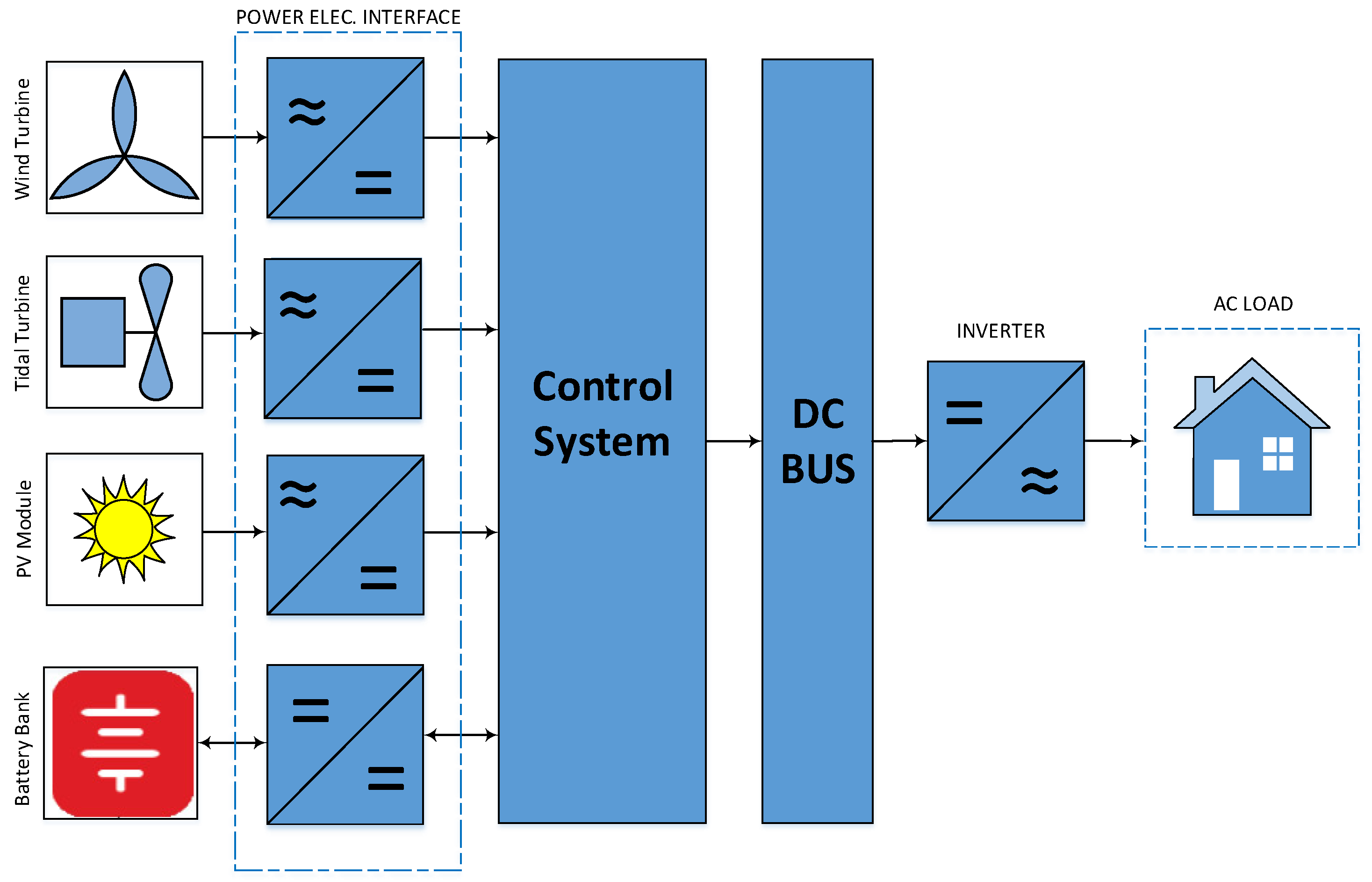
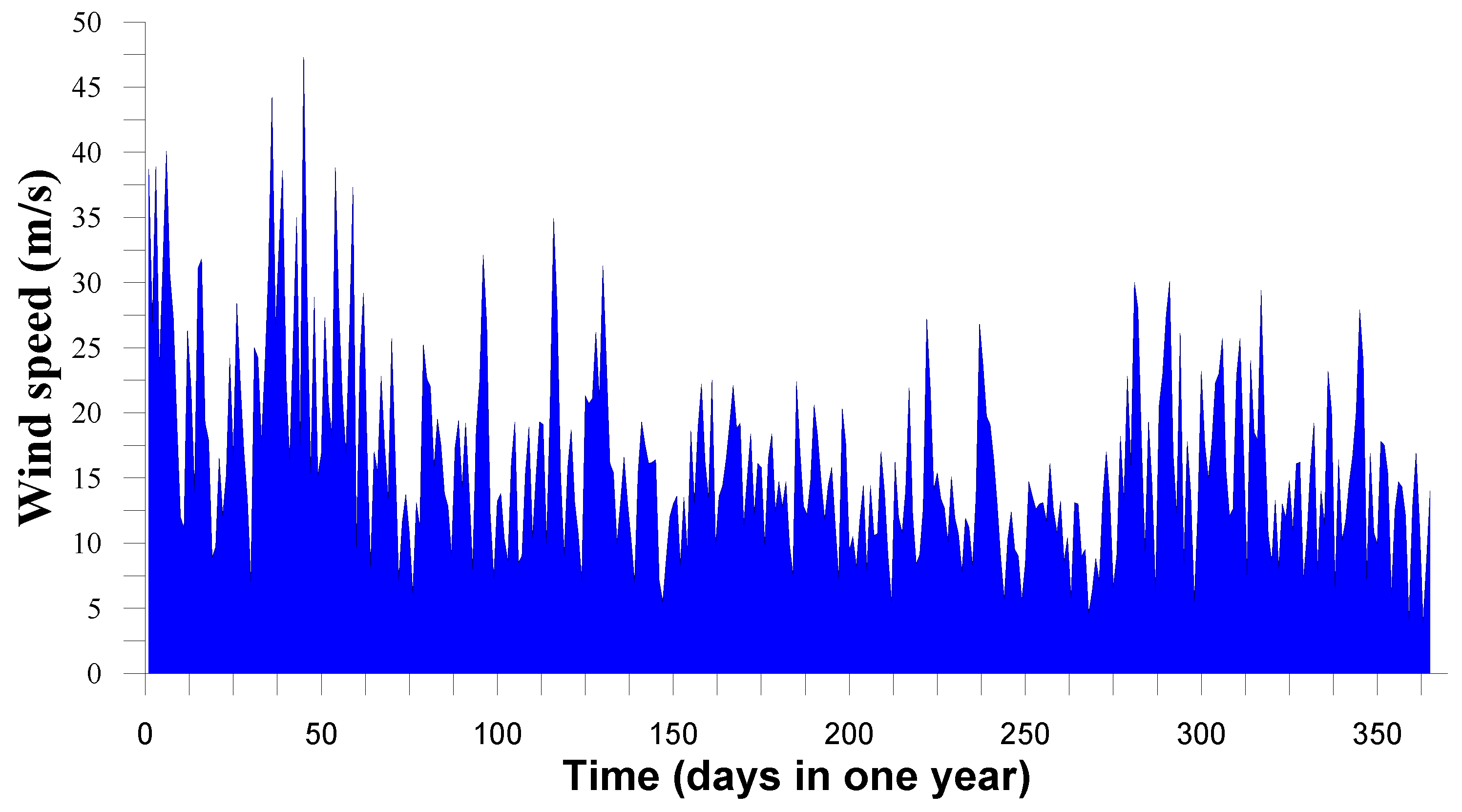
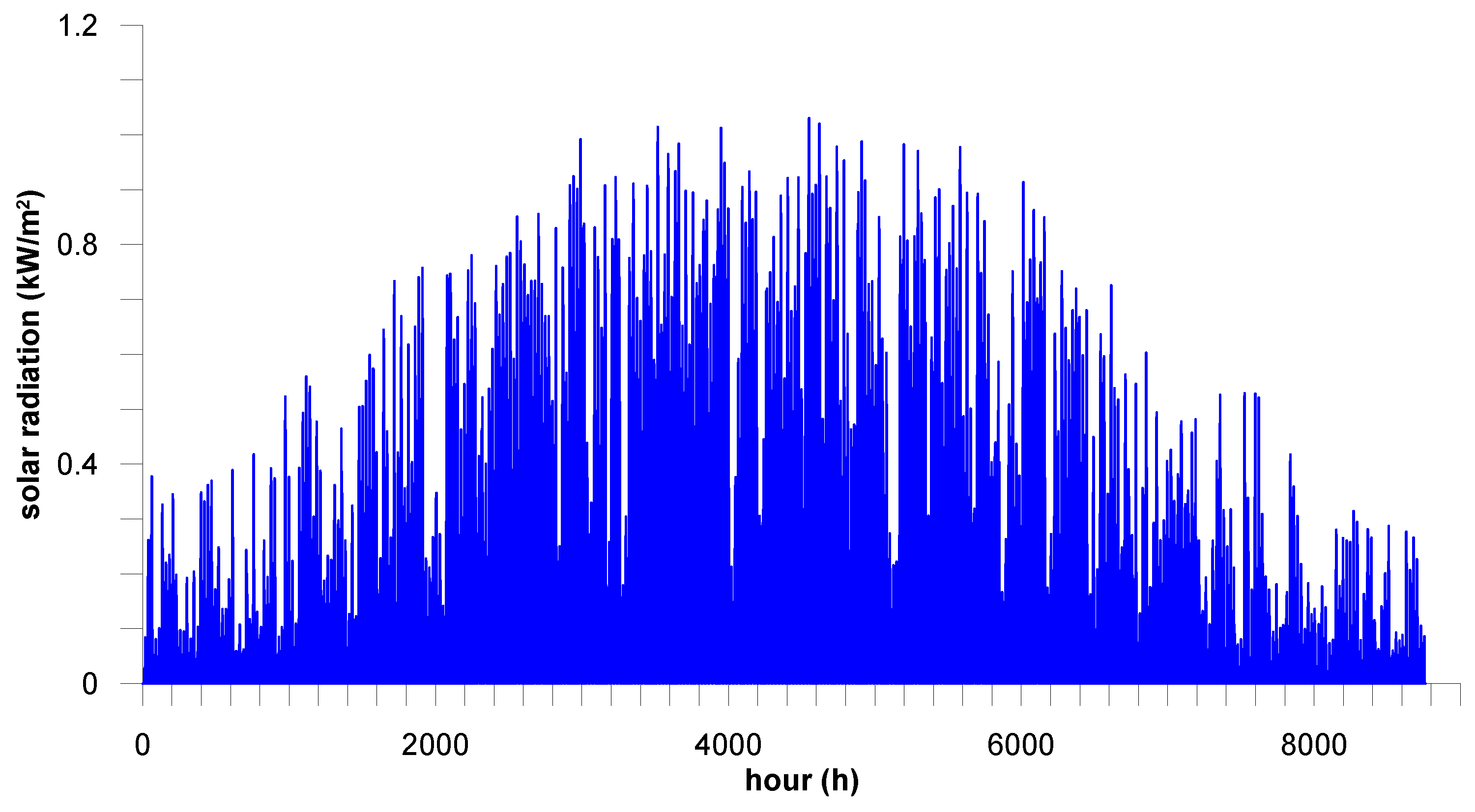

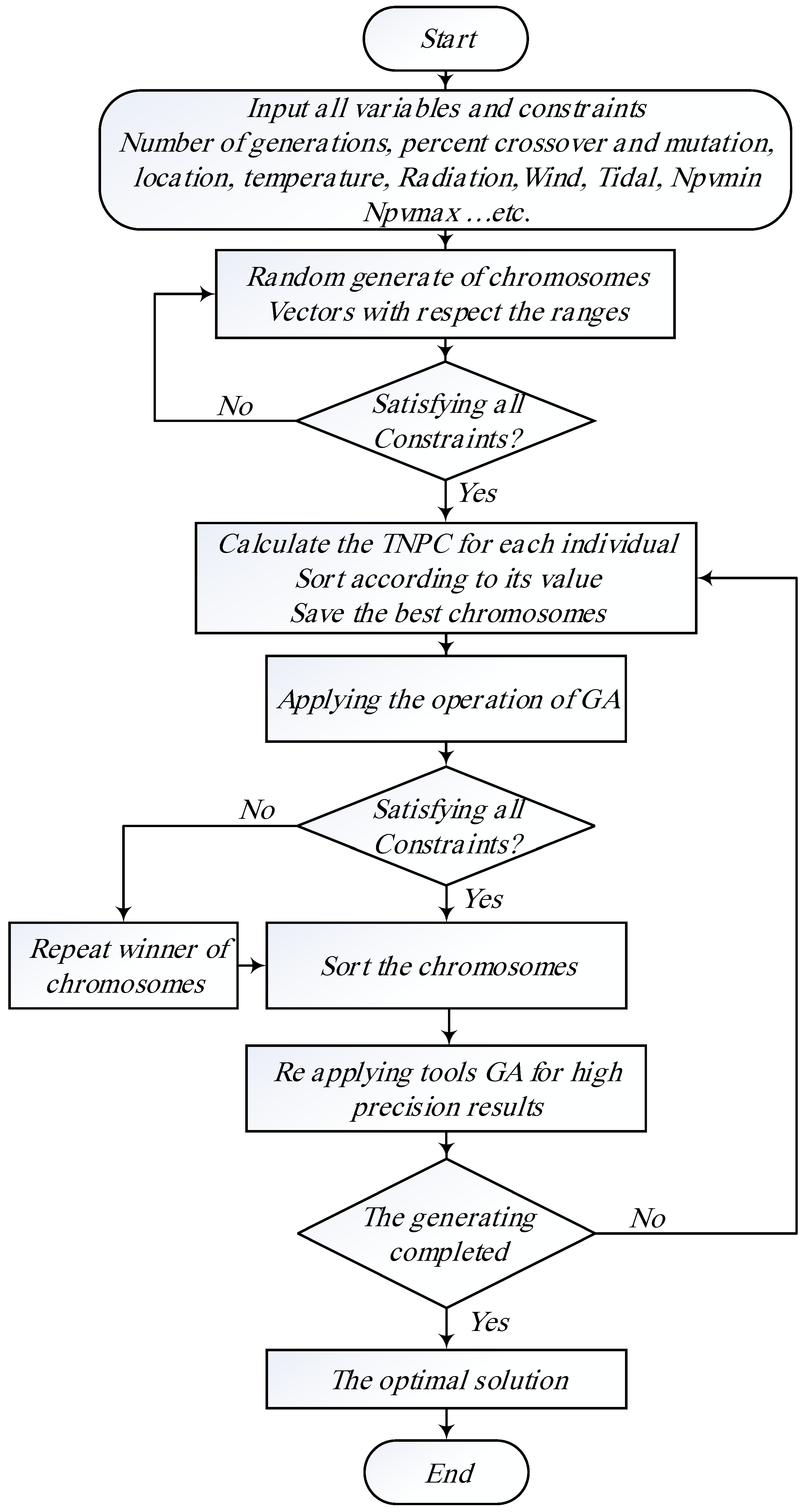
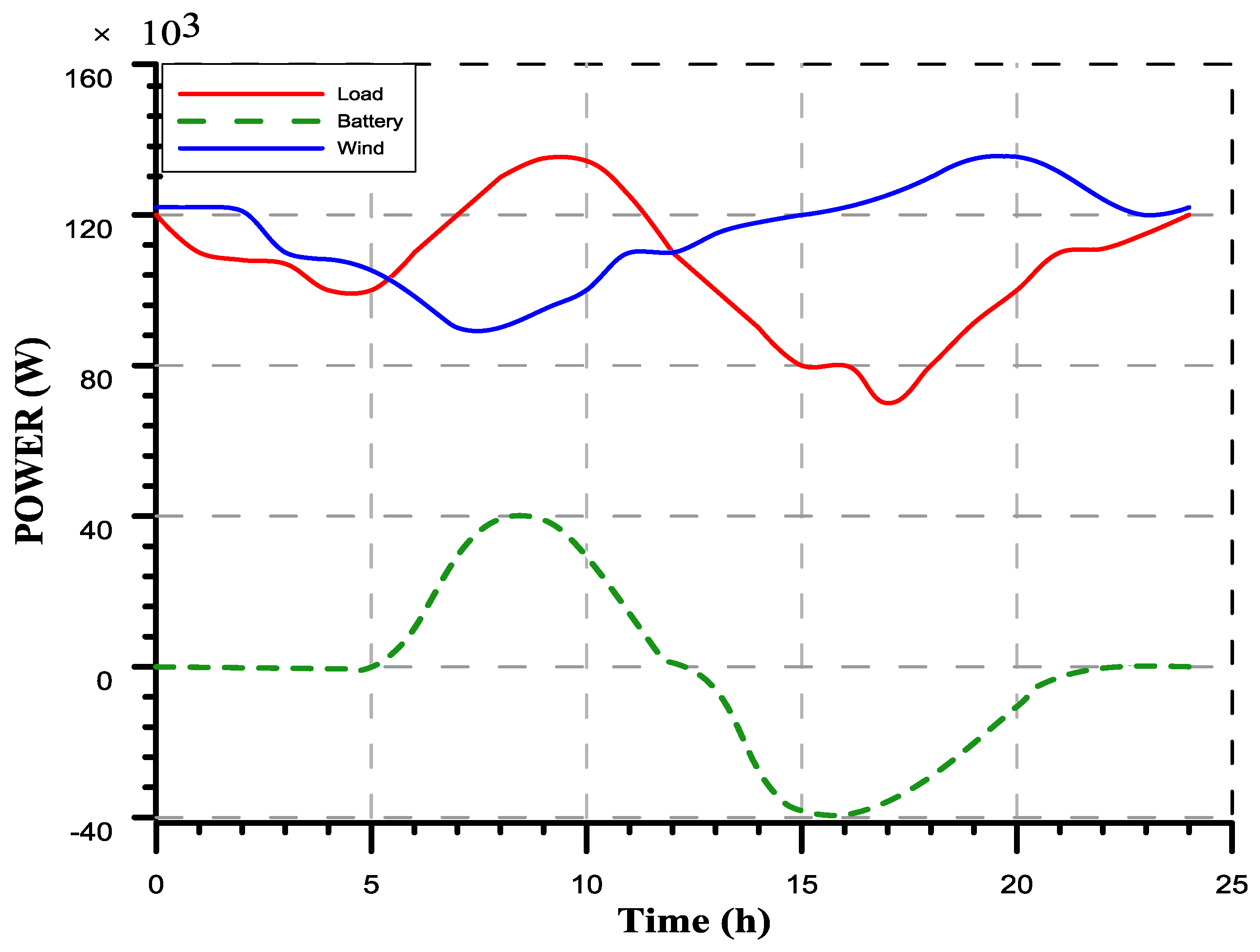

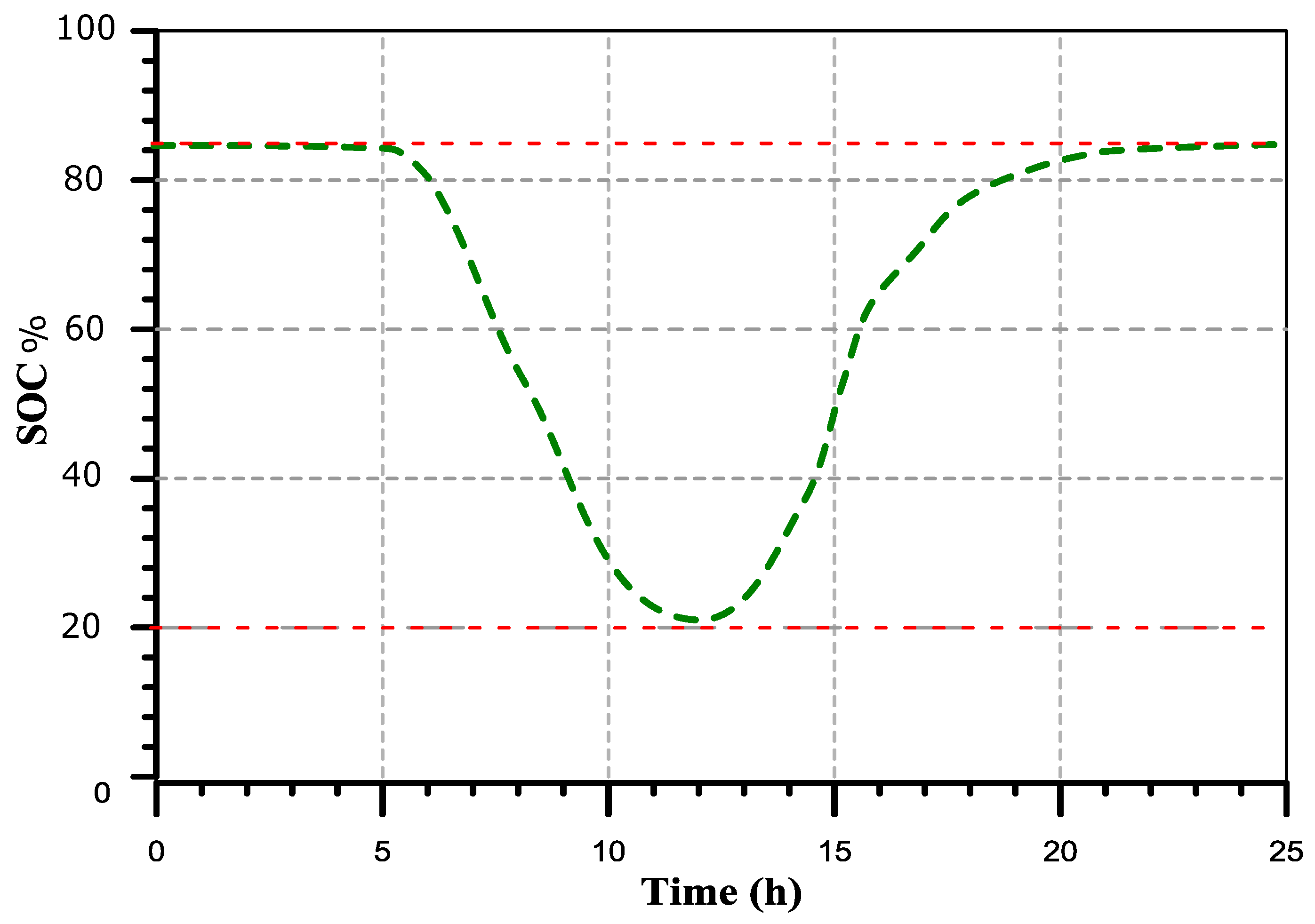
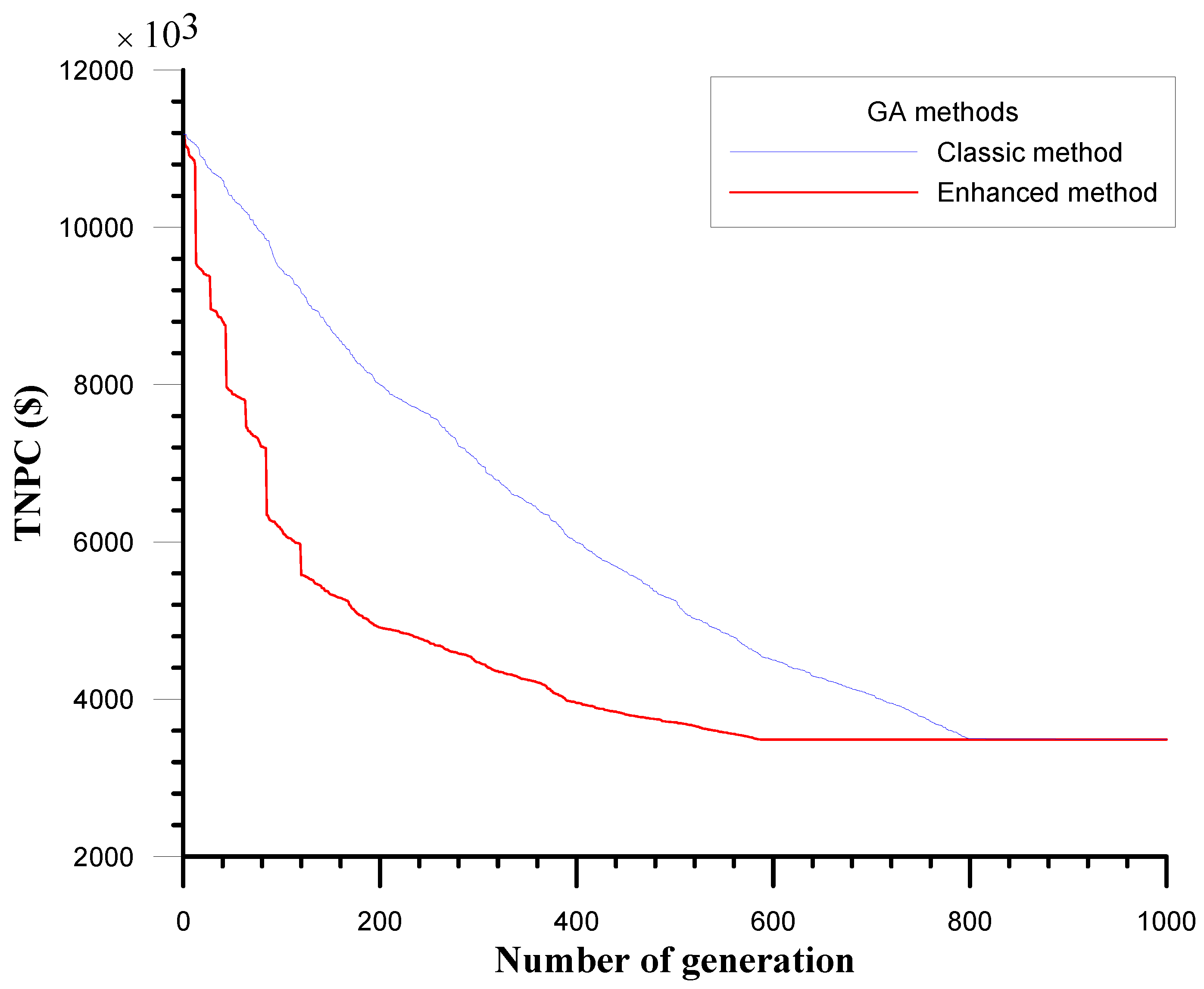
| Cut-in Speed, | 5 (m/s) |
| Cut-out Speed, | 25 (m/s) |
| Rated Speed,v | 15 (m/s) |
| The maximum output power, | MkW |
| Swept area | 3959 m |
| No. of blades | 3 |
| Rotor diameter | 71 m |
| Hub height | 57 m /64 m /85 m /98 m /113 m |
| The Rated Power | 285 W |
| The lifetime | 25 years |
| Capital Cost | 450 ($=Unit) |
| Replacement Cost | 450 ($=Unit) |
| Operation & Maintenance Cost | 5 ($=Unit/year) |
| Efficiency | 90% |
| The rated power | 500 kW |
| Cut-in tidal speed | <1 (m/s) |
| Rated tidal speed | 2.25 (m/s) |
| Cut-out tidal speed | >5 (m/s) |
| Capital Cost | 1,250,000 ($=Unit) |
| Replacement Cost | 1,250,000 ($=Unit) |
| Operation & Maintenance Cost | 1000 ($=Unit/year) |
| Efficiency | 90% |
| The nominal voltage | 100 V |
| The rated energy | 50 kWh |
| Capital Cost | 2500 ($/Unit) |
| Replacement Cost | 2500 ($/Unit) |
| Operation & Maintenance Cost | 20 ($/Unit-year) |
| Efficiency | 71% |
| No. Wind | No. Tidal | No. PV | Battery Size Wh | TNPC $ | COE $/kWh |
|---|---|---|---|---|---|
| 2 | 0 | 0 | 59,794 | 3,488,089 | 0.0942 |
| 1 | 1 | 0 | 7,577,958 | 4,522,475 | 0.1221 |
| 1 | 1 | 459 | 7,226,945 | 4,712,403 | 0.1272 |
| 0 | 6 | 0 | 8,944,118 | 9,802,486 | 0.2647 |
| 0 | 5 | 6819 | 11,175,872 | 12,336,314 | 0.3331 |
| 0 | 0 | 19998 | 1,29,429,319 | 28,278,742 | 0.7637 |
© 2018 by the authors. Licensee MDPI, Basel, Switzerland. This article is an open access article distributed under the terms and conditions of the Creative Commons Attribution (CC BY) license (http://creativecommons.org/licenses/by/4.0/).
Share and Cite
Hazem Mohammed, O.; Amirat, Y.; Benbouzid, M. Economical Evaluation and Optimal Energy Management of a Stand-Alone Hybrid Energy System Handling in Genetic Algorithm Strategies. Electronics 2018, 7, 233. https://doi.org/10.3390/electronics7100233
Hazem Mohammed O, Amirat Y, Benbouzid M. Economical Evaluation and Optimal Energy Management of a Stand-Alone Hybrid Energy System Handling in Genetic Algorithm Strategies. Electronics. 2018; 7(10):233. https://doi.org/10.3390/electronics7100233
Chicago/Turabian StyleHazem Mohammed, Omar, Yassine Amirat, and Mohamed Benbouzid. 2018. "Economical Evaluation and Optimal Energy Management of a Stand-Alone Hybrid Energy System Handling in Genetic Algorithm Strategies" Electronics 7, no. 10: 233. https://doi.org/10.3390/electronics7100233
APA StyleHazem Mohammed, O., Amirat, Y., & Benbouzid, M. (2018). Economical Evaluation and Optimal Energy Management of a Stand-Alone Hybrid Energy System Handling in Genetic Algorithm Strategies. Electronics, 7(10), 233. https://doi.org/10.3390/electronics7100233







